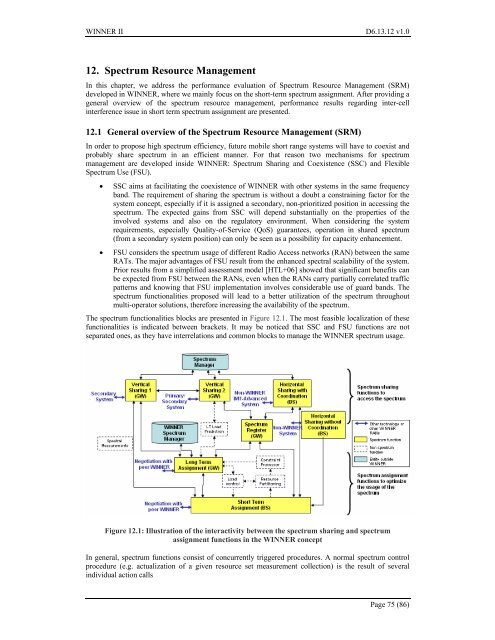IST-4-027756 WINNER II D6.13.12 v1.0 Final CG “local area ...
IST-4-027756 WINNER II D6.13.12 v1.0 Final CG “local area ...
IST-4-027756 WINNER II D6.13.12 v1.0 Final CG “local area ...
You also want an ePaper? Increase the reach of your titles
YUMPU automatically turns print PDFs into web optimized ePapers that Google loves.
<strong>WINNER</strong> <strong>II</strong> <strong>D6.13.12</strong> <strong>v1.0</strong>12. Spectrum Resource ManagementIn this chapter, we address the performance evaluation of Spectrum Resource Management (SRM)developed in <strong>WINNER</strong>, where we mainly focus on the short-term spectrum assignment. After providing ageneral overview of the spectrum resource management, performance results regarding inter-cellinterference issue in short term spectrum assignment are presented.12.1 General overview of the Spectrum Resource Management (SRM)In order to propose high spectrum efficiency, future mobile short range systems will have to coexist andprobably share spectrum in an efficient manner. For that reason two mechanisms for spectrummanagement are developed inside <strong>WINNER</strong>: Spectrum Sharing and Coexistence (SSC) and FlexibleSpectrum Use (FSU).• SSC aims at facilitating the coexistence of <strong>WINNER</strong> with other systems in the same frequencyband. The requirement of sharing the spectrum is without a doubt a constraining factor for thesystem concept, especially if it is assigned a secondary, non-prioritized position in accessing thespectrum. The expected gains from SSC will depend substantially on the properties of theinvolved systems and also on the regulatory environment. When considering the systemrequirements, especially Quality-of-Service (QoS) guarantees, operation in shared spectrum(from a secondary system position) can only be seen as a possibility for capacity enhancement.• FSU considers the spectrum usage of different Radio Access networks (RAN) between the sameRATs. The major advantages of FSU result from the enhanced spectral scalability of the system.Prior results from a simplified assessment model [HTL+06] showed that significant benefits canbe expected from FSU between the RANs, even when the RANs carry partially correlated trafficpatterns and knowing that FSU implementation involves considerable use of guard bands. Thespectrum functionalities proposed will lead to a better utilization of the spectrum throughoutmulti-operator solutions, therefore increasing the availability of the spectrum.The spectrum functionalities blocks are presented in Figure 12.1. The most feasible localization of thesefunctionalities is indicated between brackets. It may be noticed that SSC and FSU functions are notseparated ones, as they have interrelations and common blocks to manage the <strong>WINNER</strong> spectrum usage.Figure 12.1: Illustration of the interactivity between the spectrum sharing and spectrumassignment functions in the <strong>WINNER</strong> conceptIn general, spectrum functions consist of concurrently triggered procedures. A normal spectrum controlprocedure (e.g. actualization of a given resource set measurement collection) is the result of severalindividual action callsPage 75 (86)
















